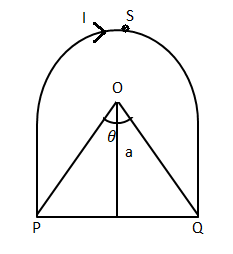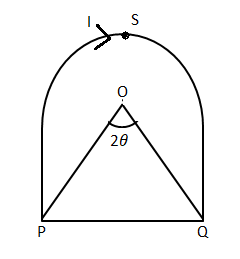Answer
36.3k+ views
Hint: The relation between current and magnetic field produced by the current is given by the Biot Savart law. Here the current is flowing clockwise. Apply the Biot Savart law on the loop PSR and PQ to obtain the magnetic field of a circle and magnetic field of a segment. Sum of the two magnetic fields gives the resultant magnetic field.
Formula used:
\[B = \dfrac{{{\mu _0}I}}{{2a}}\]
It is the magnetic field of the circle where $B$ is the magnetic field, $I$ is the current.
Complete step to step answer:
The magnetic field produced due to a current carrying segment is given by Biot Savart law. It is a vector quantity. In order to determine the magnetic field produced at a point due to this small element, one can use Biot-Savart’s Law.
Biot-Savart’s law, the magnetic field depends on
Is directly proportional to the current
Is directly proportional to the length
Current is flowing clockwise. Now let us apply the magnetic field due to the loop PSQ. Then magnetic field of a segment is
\[{B_{PSQ}} = \dfrac{{{\mu _0}I}}{{2R}}\left( {\dfrac{{2\pi - 2\theta }}{{2\pi }}} \right) - - - - - \left( 1 \right)\]
Magnetic field due to the loop PQ. The magnetic field of is
\[B = \dfrac{{{\mu _0}I}}{{2a}}\left( {\sin {\theta _1} + \sin {\theta _2}} \right) - - - - - \left( 2 \right)\]
Here a is the perpendicular distance from the point to the wire.

Here $a = r\cos \theta $
${B_{PQ}} = \dfrac{{{\mu _0}I}}{{4\pi R\cos \theta }}\left( {2\sin \theta } \right)$
${B_{PQ}} = \dfrac{{{\mu _0}I}}{{4\pi R}}\left( {2\tan \theta } \right)$
${B_{RES}} = \dfrac{{{\mu _0}I}}{{4\pi R}}\left( {2\pi - 2\theta } \right) + \dfrac{{{\mu _0}I}}{{4\pi R}}\left( {2\tan \theta } \right)$
${B_{RES}} = \dfrac{{{\mu _0}I}}{{4\pi R}}\left( {\pi - \theta + \tan \theta } \right)$
Hence option $\left( D \right)$ is the right option.
Note: Biot-Savart’s Law for the magnetic field has certain similarities as well as differences with the coulomb's law. In Biot-Savart’s Law the magnetic field is directly proportional to the sine of the angle. The magnetic field produced due to a current carrying segment is given by Biot Savart law. Biot-Savart’s Law is a vector quantity .
Formula used:
\[B = \dfrac{{{\mu _0}I}}{{2a}}\]
It is the magnetic field of the circle where $B$ is the magnetic field, $I$ is the current.
Complete step to step answer:
The magnetic field produced due to a current carrying segment is given by Biot Savart law. It is a vector quantity. In order to determine the magnetic field produced at a point due to this small element, one can use Biot-Savart’s Law.
Biot-Savart’s law, the magnetic field depends on
Is directly proportional to the current
Is directly proportional to the length
Current is flowing clockwise. Now let us apply the magnetic field due to the loop PSQ. Then magnetic field of a segment is
\[{B_{PSQ}} = \dfrac{{{\mu _0}I}}{{2R}}\left( {\dfrac{{2\pi - 2\theta }}{{2\pi }}} \right) - - - - - \left( 1 \right)\]
Magnetic field due to the loop PQ. The magnetic field of is
\[B = \dfrac{{{\mu _0}I}}{{2a}}\left( {\sin {\theta _1} + \sin {\theta _2}} \right) - - - - - \left( 2 \right)\]
Here a is the perpendicular distance from the point to the wire.

Here $a = r\cos \theta $
${B_{PQ}} = \dfrac{{{\mu _0}I}}{{4\pi R\cos \theta }}\left( {2\sin \theta } \right)$
${B_{PQ}} = \dfrac{{{\mu _0}I}}{{4\pi R}}\left( {2\tan \theta } \right)$
${B_{RES}} = \dfrac{{{\mu _0}I}}{{4\pi R}}\left( {2\pi - 2\theta } \right) + \dfrac{{{\mu _0}I}}{{4\pi R}}\left( {2\tan \theta } \right)$
${B_{RES}} = \dfrac{{{\mu _0}I}}{{4\pi R}}\left( {\pi - \theta + \tan \theta } \right)$
Hence option $\left( D \right)$ is the right option.
Note: Biot-Savart’s Law for the magnetic field has certain similarities as well as differences with the coulomb's law. In Biot-Savart’s Law the magnetic field is directly proportional to the sine of the angle. The magnetic field produced due to a current carrying segment is given by Biot Savart law. Biot-Savart’s Law is a vector quantity .
Recently Updated Pages
To get a maximum current in an external resistance class 1 physics JEE_Main

f a body travels with constant acceleration which of class 1 physics JEE_Main

A hollow sphere of mass M and radius R is rotating class 1 physics JEE_Main

If the beams of electrons and protons move parallel class 1 physics JEE_Main

Two radioactive nuclei P and Q in a given sample decay class 1 physics JEE_Main

If a wire of resistance R is stretched to double of class 12 physics JEE_Main

Other Pages
The bond order of ClO bond in ClO4 ion and the effective class 11 chemistry JEE_Main

The mole fraction of the solute in a 1 molal aqueous class 11 chemistry JEE_Main

An electric bulb has a power of 500W Express it in class 11 physics JEE_Main

The nitride ion in lithium nitride is composed of A class 11 chemistry JEE_Main

How many grams of concentrated nitric acid solution class 11 chemistry JEE_Main

when an object Is placed at a distance of 60 cm from class 12 physics JEE_Main




